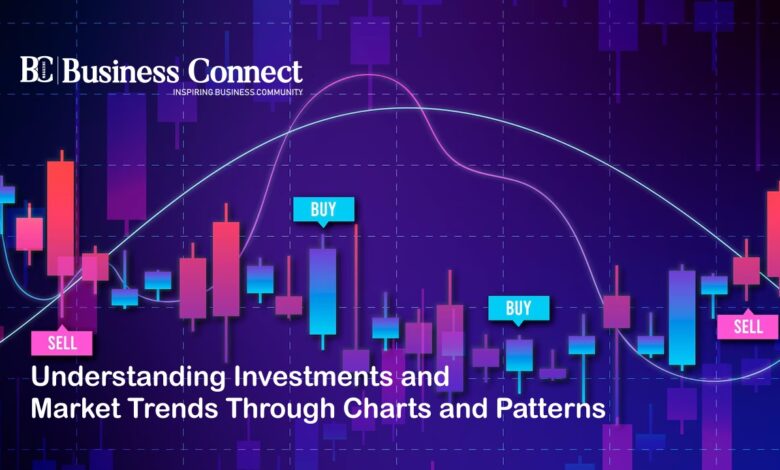Understanding Investments And Market Trends Through Charts And Patterns

Savings are very paramount especially in the attainment of financial freedom. No matter if you’re a beginner or have been investing for years it is always helpful to know how to read the market and how to incorporate effective techniques. Equity securities, foreign securities, government securities and commodities are financial securities that must be considered.
As mentioned above, in this article we will discuss what technical analysis is, why choosing charts is crucial and what factors you need to know to succeed in investing.
Technical Analysis
Technical analysis interprets market trends through charts and patterns. Investors use historical data to predict price changes. It is widely used in markets like equities, forex, and commodities.
Technical daily and weekly analyses offer short- and long-term perspectives. Indicators such as moving averages, candlestick patterns, and oscillators help identify buying and selling opportunities. Charts simplify complex market data, making analysis easier for investors.
Significance of using Charts in Technical Analysis
Charts should be considered the essence of technical analysis . They depict historical price information and are used to analyze trends in the market for different periods of time. Among the most common chart types are:
A line chart where the closing prices are presented, bar chart, where opening, closing, high and low prices are displayed and the candlestick chart that has all the information of price changes but uses color codes to distinguish between bearish and bullish.
Key Indicators for Traders
That’s why, indicators are most critical for decision-making, as they can help to make the decision-making process easier. The moving averages (MA) eliminates the noise from price data with the aim of determining the direction. While the Relative Strength Index (RSI) gauges momentum to identify values that are over or under bought.
Bollinger Bands charts depict price fluctuation and probable breakout areas and the MACD chart displays the trend and its force.
Why Volume Analysis Is a Useful Technique
Volume analysis is critical more so while analyzing the magnitude of the power behind price swings. There is some general knowledge that states if there is a high trading volume during the price increase then that can demonstrate the buying interest power, but if there is low volume that may show weakness.
Intricate oscillations may hint at early signs of the reversal of trends, and there are indicators such as the On-Balance Volume (OBV) to measure the continual accumulation and distribution of volumes.
Identifying Patterns in Prices
Patterns are known to be the fundamental basis for technical analysis. Through charts they assist the trader in considering the future shifts in prices. Some well-known models are such things as the head and shoulders formation, which tells the trader when revivals are likely to occur.
The double top or bottom, which informs the trader that reversal points are likely, and various triangular formations, which signal to the trader that continuation of the evident trend may go on or it may reverse.
Advantages of Technical approach
Technical analysis has various benefits to investors in the sense that. Timing is enhanced through the identification of entry and exit points; risk management gets a boost from a pattern recognition of probable trend changes and the subject area of market psychology and sentiment.
Also, it is flexible, relevant to use in each market domain like stocks, commodities, and forex markets.
Merging of Technical and Fundamental Analysis
Combining technical with fundamental analysis covers up the lacking part of each other since technical analysis is more of prices while fundamental analysis provides more of company information and market news.
The fundamental analysis gives information on the most undervalued stocks while the technical analysis assists in the determination of time to buy and time to sell a security.
Overcoming Misconceptions
One of the things people get wrong regarding technical analysis is that it is only applicable to the short-term trader. In fact, even long-term investors also stand to gain from the knowledge of the general feeling among the members of the market and freeing themselves from emotional biases.
In this way, they are able to enhance their managers’ total investment outcomes through adherence to data-based techniques.
Addressing Challenges
However, it has some drawbacks here and there as a tool of analysis. Measures and patterns may be in themselves assumed in various ways and past performance is not necessarily an indicator of future results.
It is therefore vital to ensure that there is correct information in use since wrong data means that wrong conclusions have been made. Furthermore, even for the short-term, information, and thus signals, can be distorted by market noise.
Risk Management: Safeguarding Your Investments
Like any business, investing comes with certain levels of risk though avoidable through risk management. Risk analysis should first be conducted in conjunction with setting a stop-loss order that will limit the overall exposure. Portfolio rebalancing is critical because it helps match your investments to your financial goals when you conduct it often.
Key aspects of risk management include:
These are factors of Granting budget responsibility based on risk appetite.
- Avoiding over-leveraging
- For the minimum wasted length of time, risk diversification or balancing the portfolio
- Learning Technical Analysis
The next step in mastering technical analysis is to study what chart basics there are and learn about the indicators. Develop an account of trade on demo accounts to learn all the functions without actually using real money. Be contested with the market data and try to extend your knowledge by reading books or attending courses.
Tools for Technical Analysis
Today there is a large number of technical tools available on modern trading platforms. MetaTrader 4 and MetaTrader 5 are very functional forex trading platforms appropriate for first-time traders and experienced ones. TradingView offers charting and community options whereas NinjaTrader is a platform for futures and forex traders.
A Real-Life Application
For example, picture the forex trader applying technical analysis for their trading. when using moving averages they see a bullish trend and upon checking with the RSI they proceed to open a long position.
Observing support levels and putting a stop-loss gives less risk, yet the trading session makes a profitable trade. It is very useful to showcase this form of technical analysis given that real life situations are used.
Conclusion
Learning technical analysis is more important as it adds a positive progression to the investment strategies that you make. That is why knowing its tools and concepts will help enhance the actor’s confidence when dealing with the financial markets even if the actor is a novice trader or has years of experience.
Begin using technical analysis while trading as a strategy for boosting the competitiveness and effectiveness of the trader.






